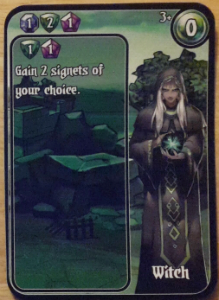Long before formalized college programs and modernly regulated trade work, people still sought to provide valuable life skills for their children. In the days prior to general schooling, it was a parent’s wish that their children would make a mark on their world – often quite literally – by learning a trade. These children would be sent to live under the tutelage of master craftsmen for several years in the hopes that, in turn, they would have a meaningful and successful career of their own.
Oh Johnny Tremain, you would have made such a wonderful silversmith…
While we have moved away from youth-based guild training, this is par for the course in the empires of Zidal. The population is growing, and their kingdoms need skilled workers. So let’s stoke the fires, till the fields, and break out an abacus. It’s time to bestow knowledge upon some young minds.
The Premise
The land of Zidal, bearing its name from a failed attempt at unifying the five kingdoms, continues to experience tension and conflict. Peace has never been lasting in Zidal, as each kingdom continues to plot, scheme, and strategize in the hopes of being stronger and more prosperous than their neighbors. To achieve success, each player must guide their kingdom to prominence by carefully planning and utilizing the various workers, artisans, and/or military personnel available.
The Rules
As Empires of Zidal is a deckbuilding game, it does require with some preparation. However, setup is rather expedient: Zidal provides two removable bins to be placed directly on the game board. One bin contains the signet tokens from the game’s five factions – Military, Market, Magic, Labor, and Entertainment – and the goal is to acquire VP in the form of these signets. The other bin contains the game’s resources of Silver, Ruby, Sapphire, Emerald, Topaz, and Amethyst. These gems are also used to create the starting resource marketplace.
There are three card types in Zidal: Building, Worker, and Child. Building cards are distributed on one side of the board, while Worker and Child cards placed on the other. The exact amount of cards used will vary depending on the number of players.
To begin, each player receives a starting deck of basic resource-generating cards and a pair of Child workers. Additionally, each player will have the option of starting with a free Worker card or another Child and extra resources. Once decided, each player draws five cards to start.
Turn structure in Empires of Zidal is quite basic. Technically, each turn consists of five steps: Reduce Active Workers, Play Cards, Discard, Add A Child, and Draw. However, each step but Play Cards are simple upkeep actions.
In the Reduce Active Workers step, the player reduces all Worker card abilities played in previous turns with the phrase “When Active From __.” These cards aren’t discarded when used and instead remain in play for a stated number of turns.
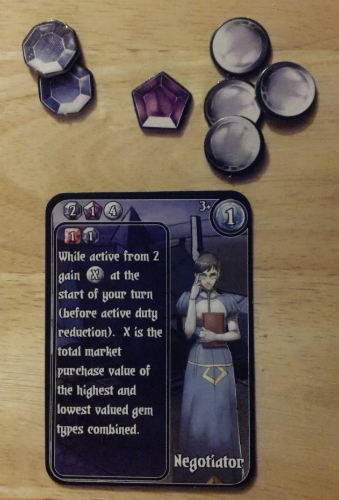
The Negotiator requires 2 Sapphires, 1 Amethyst and 4 Silver to purchase, and it’s worth 1 VP. Playing its ability will require a Ruby and a Sapphire, and it’ll stay out as an Active Worker.
The majority of the game takes place in the Play Cards steps. Here, players may use as many cards from their hand as they wish and in any order. Most cards have one or more abilities that can be played, which is done by paying the listed ability cost.
Additionally, new cards may be bought. The top card of each Worker pile is available for purchase. To “train” a new Worker (gaining the card), the player pays the requisite purchase cost, returns a Child card from their hand to the supply, and adds the card to their discard pile.
Players may also purchase up to three Building cards during the game. Building cards are more costly and provide significant bonuses, but they are not added to a player’s deck.
If a player is missing the necessary gems or silver to pay a card’s full ability or purchase costs from their resource pool, they may visit game’s marketplace. There, various gems can be bought or sold at the stated values as often as needed.
When a player has taken all of their actions, they finalize their turn by discarding the remainder of their hand, adding a new Child card from the supply to their discard pile, and drawing a new hand of five cards. Then it’s the next player turn.
Players continue to utilize new farmers, sorcerers and merchants until all signets of one faction are claimed. At that point, the game immediately ends. Players count up the total value of all of their signet tokens, cards with VP in their deck, and any bonuses from Buildings.
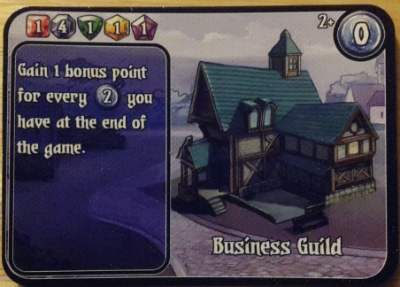
Behold the power of the Merchants.
The winner is the player with the highest signet total. They proceed to be lauded as the most successful ruler among the five kingdoms of Zidal. Everyone else should probably consider a new line of work before the masses find out they failed.
The Not-So-Invisible Hands
The most noteworthy aspect of Empires of Zidal is the way it uses the marketplace to controls resources. Zidal welds two distinctly different game mechanics together to achieve this. On the one hand, you have the classic deckbuilder model: acquiring resources to get better cards, which in turn hopefully steer you to victory. On the other hand, you have a purely supply-and-demand market mechanic that’s more commonly seen in Euro games. In order to ensure the market got utilized, though, Zidal made two risky ventures that ultimately paid off.
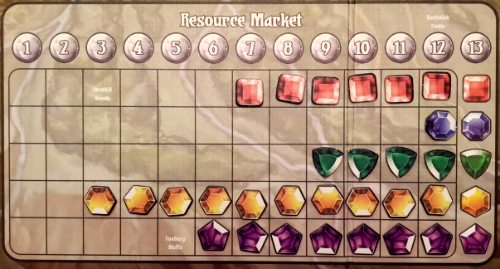
At the moment, Sapphire is demanding high prices, while Topaz is in abundance.
First, Zidal does not have upgrades to the basic resource cards. While different Worker cards can steal or generate resources for you by paying their costs, there is no second tier of resource cards. This not only requires players to be meticulous with their resources, but it also forces players to turn to the marketplace when their resources become scarce.
Second, Empires of Zidal does not have deck culling – removing unwanted cards from the deck. Most deckbuilders use culling of some kind, helping players tune decks to be speedier and more combo-friendly.
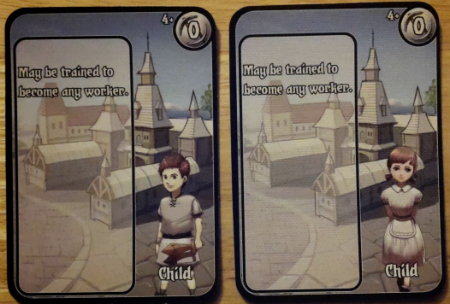
Children are our future. And also a commodity.
With Zidal, your deck size will almost always increase by one card each turn. Regardless of whether or not you purchase a Worker, unless the pile of Child cards is empty you’ll receive another Child each turn. While thematically this makes sense, it also makes planning for specific resources more difficult. As your deck grows, you see the basic resource cards less frequently. In turn, that means less free gems and silver. Enter the marketplace to make up the difference.
Finding The Right Match
However, the absence of culling will not sit well with everyone. A steadily-increasing deck decreases the tempo to a deckbuilder and increases the randomness to your draws. This will cause some, namely Strikers, to feel like they lack some control over the situation. Zidal is likely not a deckbuilder for them.
A similar thing could be said about Tacticians, as they’ll initially see a game that inhibits long-term planning and multi-card combos. However, if a Tactician approaches Empires of Zidal less as a deckbuilder using a market mechanic and more of a Resource Management game with a deckbuilding mechanic, they should still find it enjoyable.
Combos or not, the game does have plenty of synergy. While it’s true that the largest rewards come from focusing on a single guild, the interactions between different faction cards are both varied and useful. Exploring these interactions should appeal to variety-seeking Daredevils, but the aforementioned uses of resource management and a reduced tempo may diminish their interest after a handful of playthroughs.
Card interactions also can be entertaining from an Immersionist’s point of view. How does cooperation between the Military and Entertainer guilds fare? What would a town of Laborers and Magic users be like? It is these concepts that underscore the game’s theme. There is a tenable world being played out in Empires of Zidal, albeit one mostly surface-based. Still, given that deckbuilders aren’t known for deeply resonant themes, that Zidal has any pertinent theme should be enough to catch an Immersionist’s attention.

…and Timmy, you’ve been apprenticed to Mr. Palpatine.
What’s more, because the game is entirely about the growth of one’s empire and populating it with all the peoples, Zidal hits a lot of the buttons that Architects appreciate. You are literally building towards victory after all. Don’t be surprised though if they (and players in general) occasionally make jokes about turning your Child into a Necromancer or a Grunt. Sure, this could have been sidestepped by simply referring to the kids as Apprentices, but clearly the citizens of Zidal don’t mince words.
Regardless of how it is approached, however, this is not a game for Socializers. As with most deckbuilders, there is not a lot of player interaction. Aside from a few attack cards or preventing someone from gaining a specific Worker, players mostly focus on their own goals. Moreover, Zidal is longer than most deckbuilders. In needing to acquire all 36 of a faction’s signets, the game can potentially drag in the late stages of the game. We found that the best solution to this is simply to decrease the number of signets per faction. We recommend only actually using between 20-24, as the winner at this point is usually the same person to reach 36 first anyway.
Building Empires
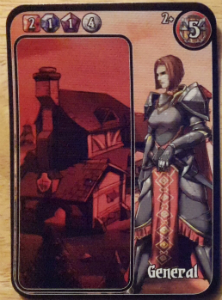
She’s a General, fully armored, and worth 5 VP.
Materially speaking, Zidal proves to be bittersweet. From the board to the tokens, all of the cardboard components have decent durability, and the removable trays are a nice addition for organization and quick setup (though we often do abandon the resource bin at some point).
The medieval fantasy artwork also deserves praise, not only because of the quality of the drawings, but also because of how it largely avoids succumbing to fan service. Indeed, Zidal does a great job of depicting a wide spectrum of body types and gender balance you’d expect in an actual kingdom.
Yet Zidal does have one very apparent weakness: the cards are rather thin. It’s hard to overlook this fact. This will make some wary of the game on a visceral level, but it should be noted that it doesn’t detract much from the gameplay itself. The cards do come with a nice matte finish – which certainly helps – but given it’s a card game with repeated shuffling and usage, this is an unfortunate misstep that detracts from the overall presentation. It’s recommended in the long run to consider sleeving these cards, preferably in a thicker sleeve option as to give the cards some rigidity.
The Takeaway
Empires of Zidal makes a unique mark in the deckbuilder camp. It extracted the self-contained economic engines common to the genre and supplemented it through use of a marketplace mechanic. This does alter the general flow of the game, as players must focus much more on resource management than at first thought, and this provides players with a whole new deckbuilding experience. Zidal has a pleasantly basic theme, while at the same time generating both balance and diversity across all five factions in the game. Sessions can take a little longer than is probably ideal, and the cards could benefit from an upgrade, but both of these factors can be mitigated with relative ease. Ultimately, Empires of Zidal proves to be a successful hybrid experiment between a deckbuilder and a resource management game. It’s surprisingly easy to learn and has some definite replay value for fans of either style of game. If you’re a fan of market-based mechanics, or deckbuilders with a twist, Empires of Zidal has something to offer you. Just remember though – they only take payment in gemstones.
Empires of Zidal is a product of Dog Breath Games.
Cardboard Republic Snapshot Scoring (Based on scale of 5):
Artwork: 4.5
Rules Clarity: 4.5
Replay Value: 4
Physical Quality: 3
Overall Score: 3.5

